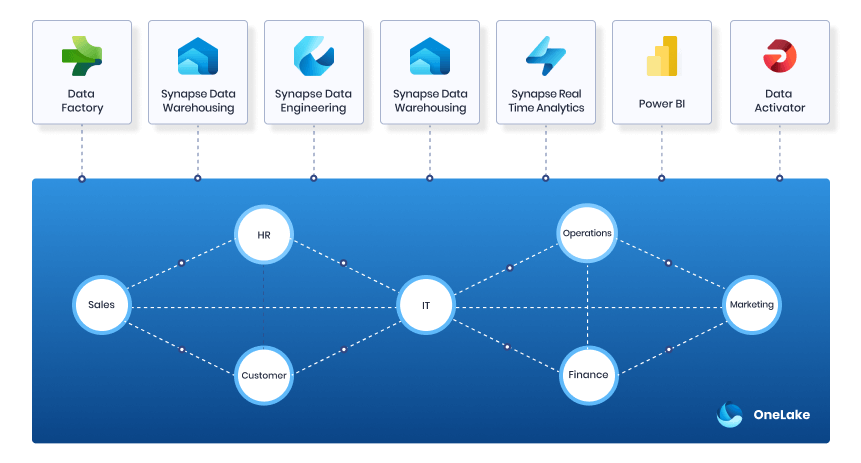Microsoft Fabric is an ideal platform for implementing Data Mesh architecture due to its comprehensive features and capabilities that align with the principles of Data Mesh.
What is Microsoft Fabric?
Microsoft Fabric is a SaaS (Software as a Service) that encapsulates power bi plus a lot of stuff we have seen in synapse and other areas of azure, no software to install or to configure. One of its key features is the separation of storage and compute, allowing you to run those different compute workloads on the same sets of data.

What is Data Mesh?
Data mesh is a domain-oriented decentralization for data access. Data mesh architecture shifts the responsibility of data access from the data or technology teams to the business teams.it mainly follows the 4 principles.
- Domain ownership
- Data as a product
- Self-serve data infrastructure
- Federated data governance
Here’s how Microsoft Fabric supports Data Mesh effectively:

1. Integrated Data Ecosystem
Unified Platform: Microsoft Fabric combines various data services, including data integration, data engineering, data warehousing, and data science, into a single ecosystem. This integration facilitates seamless collaboration between domain teams, essential for the decentralized approach of Data Mesh.
2. Decentralized Data Ownership
Domain-Centric Management: Microsoft Fabric allows organizations to empower individual domain teams to manage their data products. Each team can create, maintain, and optimize their datasets without relying on a centralized data team, promoting a culture of accountability and ownership.
3. Self-Serve Data Infrastructure
User-Friendly Tools: Microsoft Fabric provides intuitive tools that enable domain teams to ingest, transform, and analyze data independently. This self-serve capability aligns with the Data Mesh principle of allowing teams to manage their data without extensive IT support.
4. Robust Data Governance
Federated Governance Framework: Microsoft Fabric supports a federated approach to governance, allowing organizations to maintain control over data access, security, and compliance while enabling autonomy for domain teams. This ensures that data remains secure and adheres to regulatory requirements while fostering innovation.
5. Scalability and Performance
Elastic Scalability: Microsoft Fabric is designed to handle large volumes of data and can scale resources up or down based on demand. This elasticity is crucial for Data Mesh implementations, where different teams may have varying data needs and workloads
6. Data Quality and Trust
Data Observability: With features like data lineage and monitoring, Microsoft Fabric helps teams maintain high data quality and trust. Teams can track the origin and transformation of their data products, ensuring accuracy and reliability, which is vital for data-driven decision-making.
7. Enhanced Collaboration
Cross-Team Collaboration: Microsoft Fabric enables easy data sharing and collaboration between domain teams. This allows teams to leverage each other’s data products, driving innovation and improving insights across the organization.
8. Advanced Analytics Capabilities
Built-In Analytical Tools: Microsoft Fabric integrates advanced analytics capabilities, such as machine learning and AI, directly into the data platform. This allows teams to create and iterate on data products quickly, supporting the agile nature of Data Mesh.
9. Seamless Data Integration
Support for Diverse Data Sources: Microsoft Fabric allows teams to integrate data from various sources, including on-premises systems, cloud services, and third-party applications. This flexibility enables domain teams to access and utilize all relevant data for their analytics needs.
10. Cost Efficiency
Pay-As-You-Go Model: Microsoft Fabric’s consumption-based pricing model ensures that organizations only pay for the resources they use. This aligns with the decentralized nature of Data Mesh, where individual teams can manage their costs based on their specific data workloads.
Example Scenario
Organization Overview: Imagine a retail organization with three domain teams: Sales, Inventory, and Marketing.
- Sales Team: They manage a data product that includes customer sales data and can quickly analyse sales trends by region.
- Inventory Team: They oversee inventory levels and product availability across different locations.
- Marketing Team: They focus on campaign effectiveness and customer engagement metrics.

Implementing Data Mesh with Microsoft Fabric
- Each team uses Microsoft Fabric to manage their own data products. The Sales Team can ingest sales data from various sources using Azure Data Factory, store it in a Lakehouse, and run analytics with Power BI for visualization.
- The Inventory Team can similarly set up their own data pipelines to track stock levels and generate alerts for low inventory.
- The Marketing Team uses insights from both the Sales and Inventory Teams, accessing shared data products through Microsoft Fabric’s data-sharing capabilities.
Conclusion
Implementing a Data Mesh architecture in Microsoft Fabric empowers organizations to manage their data more effectively. By decentralizing data ownership, leveraging domain expertise, and providing robust tools, companies can achieve scalability, agility, and enhanced data quality.
Microsoft Fabric’s capabilities align perfectly with Data Mesh principles, allowing organizations to transform their data landscape and drive better business outcomes.
Get Started with Acuvate MS Fabric Services!
Looking to enhance your experience with MS Fabric? Complete the form below to submit your service request. Our expert team is ready to assist you!



